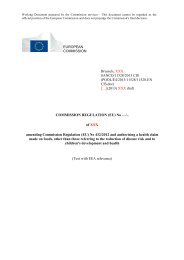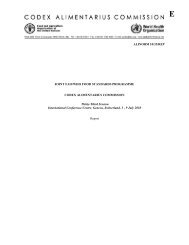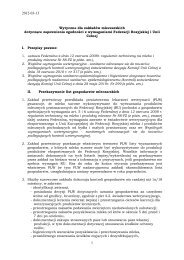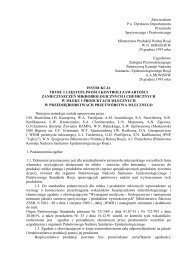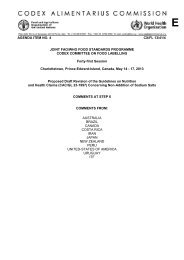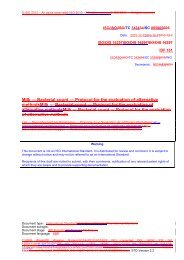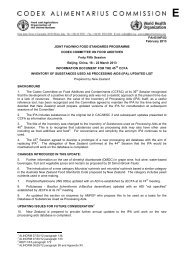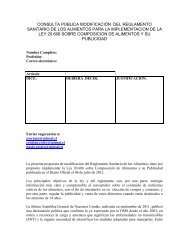ALINORM 03/32 - CODEX Alimentarius
ALINORM 03/32 - CODEX Alimentarius
ALINORM 03/32 - CODEX Alimentarius
You also want an ePaper? Increase the reach of your titles
YUMPU automatically turns print PDFs into web optimized ePapers that Google loves.
REP 13/FA 16<br />
128. The Committee noted that the new substance polyvinyl alcohol (PVA)-polyethylene glycol (PEG) graft<br />
co-polymer proposed for safety evaluation by JECFA did not have INS number and agreed to refer it to the e-<br />
WG on INS (see para. 115).<br />
129. The Committee noted that JECFA would evaluate all compounds proposed for safety evaluation for<br />
use in infant formula and formulae for special medical purposes intended for infants together; therefore, it<br />
agreed to assign the same high priority to the evaluation of these compounds.<br />
Conclusion<br />
130. The Committee agreed to forward the Priority List of Compounds Proposed for Evaluation to FAO and<br />
WHO for their follow-up (Appendix XI).<br />
PROPOSED PRIORITIZED LIST OF COLOURS FOR RE-EVALUATION BY JECFA (Agenda Item 8b) 25<br />
131. The Delegation of Canada introduced CX/FA 13/45/17 and explained that the electronic Working<br />
Group had used the Food Additive Re-evaluation Prioritization Form (the “Prioritization Form”), as revised by<br />
the 44 th CCFA, to prioritise the 107 food colours evaluated by JECFA since 1956. The Delegation noted that<br />
38 colours passed the pre-screening Section, which eliminated all the colours that did not have a provision in<br />
the GSFA or in a food Codex standard or in the Codex Step process. These 38 colours had then been<br />
assessed using the Prioritization Form and each colour was given a qualitative score for every question in<br />
the form, which resulted in a qualitative score for each of the three sections, from which a final numerical<br />
score was derived. The final ranking of the food colours for prioritization for re-evaluation by JECFA is<br />
presented in Table 1 of CX/FA 13/45/17.<br />
1<strong>32</strong>. The Delegation further explained that, as a result of this exercise, the Working Group had made<br />
several recommendations aimed at improving the efficiency of the prioritization process, including: (i)<br />
prioritise only those additives that pass the first pre-screening question in the Prioritization Form (i.e.<br />
additives for which there is a provision in the GSFA, in a Codex food standard, or in the Codex step<br />
process); (ii) change the wording of Question A1 of the Prioritization Form to consider the World Health<br />
Organization Technical Report Series (TRS) or Food Additive Series (FAS) reports, in addition to the JECFA<br />
website, as sources for the date of the latest JECFA evaluation of an additive; (iii) include a second prescreening<br />
question to the Prioritization Form to screen out additives that are currently under review by<br />
JECFA or for which JECFA has requested information by a specified date; and (iv) revise question A2 of the<br />
Prioritization Form to specifically exclude variation in a food additive that is a result of variation in the source<br />
material and is not related to the manufacturing process if the variation could be addressed through JECFA’s<br />
specifications for the additive.<br />
133. The electronic Working Group recommended that the Committee consider: (i) the revised Prioritization<br />
Form, as presented in Appendix 1 of CX/FA 13/45/17, for developing prioritised lists of food additives for reevaluation<br />
for JECFA’s consideration; and (ii) consider the ranking of the food colours, as shown in Table 1 of<br />
CX/FA 13/45/17, for recommending to JECFA the prioritization of colours for re-evaluation. It was further<br />
noted that quinoline yellow (INS 104) should be taken off the list as it is currently under review by JECFA. It<br />
was also noted that a new intake assessment of the caramel colours, published after the Working Group had<br />
finished its work, would lead caramel colours, class III and IV to have a prioritization score of “5” rather than<br />
“4” (i.e. lower priority), the same as the score for caramel colours, class I and II.<br />
Discussion<br />
134. The Committee noted that the Working Group had made a useful exercise, which had resulted in a set<br />
of recommendations aiming at improving the efficiency of the prioritization exercise and in a prioritised list of<br />
colours for re-evaluation by JECFA.<br />
135. With regard to this exercise several delegations pointed out that if there was any study suggesting a<br />
serious health concern for a specific compound, this should be taken off the prioritised list and be included in<br />
the Priority List for JECFA evaluation; these delegations also suggested to add to the Prioritization Form a<br />
third pre-screening question to screen out additives that are no longer in use.<br />
136. One Delegation expressed a concern that the possibility of limitations and gaps in the already<br />
available information on the individual food colours is not sufficiently weighted in the prioritization procedures<br />
137. The Committee had some discussion on how to use the ranking of colours, presented in Table 1 of<br />
CX/FA 13/45/17 and which steps should be taken in order for JECFA to re-evaluate the colours. In this<br />
regard it was noted that this exercise only allowed for the identification of new studies that have become<br />
25 CX/FA 13/45/17; CRD 16 (Comments of China, European Union, Mali and African Union)



